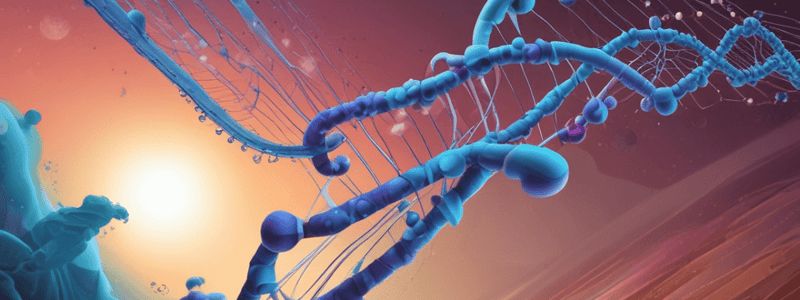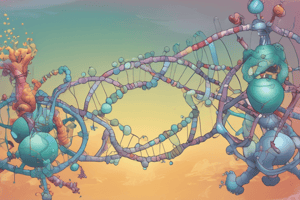Podcast
Questions and Answers
What is the primary function of introns in gene regulation?
What is the primary function of introns in gene regulation?
- To influence the removal of exons from the primary transcript
- To perform specific functions in the cell through spliceosome-independent splicing (correct)
- To provide an additional site for gene expression
- To repress the transcription of genetic information
What is the significance of spliceosome-independent splicing in gene regulation?
What is the significance of spliceosome-independent splicing in gene regulation?
- It enables the use of alternative splicing pathways (correct)
- It allows for the inhibition of gene expression
- It enhances the translation of genetic information
- It promotes the degradation of messenger RNA
What is the implication of spliceosome-independent splicing on RNA processing?
What is the implication of spliceosome-independent splicing on RNA processing?
- It increases the efficiency of RNA translation
- It reduces the complexity of RNA processing
- It influences the expression of genes by removing introns (correct)
- It has no effect on RNA processing mechanisms
What is the evolutionary significance of self-splicing introns?
What is the evolutionary significance of self-splicing introns?
What is the significance of studying spliceosome-independent splicing mechanisms?
What is the significance of studying spliceosome-independent splicing mechanisms?
What is the primary function of introns in eukaryotic genes?
What is the primary function of introns in eukaryotic genes?
What is the role of spliceosomes in eukaryotic cells?
What is the role of spliceosomes in eukaryotic cells?
What is the primary mechanism of spliceosome-independent splicing?
What is the primary mechanism of spliceosome-independent splicing?
What is the result of intron removal during RNA processing?
What is the result of intron removal during RNA processing?
What is the significance of group I and II introns in RNA processing?
What is the significance of group I and II introns in RNA processing?
What is the significance of tRNA splicing in RNA processing?
What is the significance of tRNA splicing in RNA processing?
What is a characteristic of mitochondrial introns found in fungi and yeast?
What is a characteristic of mitochondrial introns found in fungi and yeast?
What is a key feature of introns found in mitochondrial RNAs of fungi and yeast?
What is a key feature of introns found in mitochondrial RNAs of fungi and yeast?
What is a difference between group I and group II introns?
What is a difference between group I and group II introns?
What is the role of the nucleotide A in the splicing process of spliceosomal introns?
What is the role of the nucleotide A in the splicing process of spliceosomal introns?
What is the function of U2 and U6 RNA molecules in the splicing process of spliceosomal introns?
What is the function of U2 and U6 RNA molecules in the splicing process of spliceosomal introns?
What is the difference between the mechanism of autocatalysis in nuclear introns and mitochondrial introns?
What is the difference between the mechanism of autocatalysis in nuclear introns and mitochondrial introns?
What is the crucial factor that determines whether a reaction takes place in non-spliceosomal introns?
What is the crucial factor that determines whether a reaction takes place in non-spliceosomal introns?
What is the characteristic feature of the autocatalytic reaction in type II introns?
What is the characteristic feature of the autocatalytic reaction in type II introns?
What is the similarity between the structures of type II introns and spliceosomes?
What is the similarity between the structures of type II introns and spliceosomes?
What is the role of RNA polymerase II in the process of type II intron splicing?
What is the role of RNA polymerase II in the process of type II intron splicing?
What is the significance of the 2'OH group in type II intron splicing?
What is the significance of the 2'OH group in type II intron splicing?
What is the effect of the correct folding of the intron on the splicing reaction?
What is the effect of the correct folding of the intron on the splicing reaction?
What is the key difference between autocatalytic splicing of introns and spliceosomal splicing?
What is the key difference between autocatalytic splicing of introns and spliceosomal splicing?
What is the role of the GTP molecule in autocatalytic splicing?
What is the role of the GTP molecule in autocatalytic splicing?
What is the term used to describe the autocatalytic activity of introns and the RNase P?
What is the term used to describe the autocatalytic activity of introns and the RNase P?
What is the product of the autocatalytic splicing reaction in group I introns?
What is the product of the autocatalytic splicing reaction in group I introns?
What is the term used to describe the reaction in which a part of the RNA molecule acts on itself?
What is the term used to describe the reaction in which a part of the RNA molecule acts on itself?
What is the role of the U-snRNAs in the spliceosome?
What is the role of the U-snRNAs in the spliceosome?
What is the characteristic of the secondary structure of group I introns?
What is the characteristic of the secondary structure of group I introns?
What is the main challenge in the acquisition of secondary structure of introns?
What is the main challenge in the acquisition of secondary structure of introns?
What is the role of chaperones in the context of intron folding?
What is the role of chaperones in the context of intron folding?
What is the function of maturases?
What is the function of maturases?
What is the significance of the presence of a stop codon in the intron?
What is the significance of the presence of a stop codon in the intron?
What is unique about maturases encoded by the intron?
What is unique about maturases encoded by the intron?
What is the main difference between introns of type I and type II?
What is the main difference between introns of type I and type II?
Study Notes
Intron Definition
- An intron is a non-coding region of DNA within a gene that is removed during RNA processing to form a mature RNA molecule.
- Introns are typically found in eukaryotic genes, but can also be present in some prokaryotic genes.
- Introns are flanked by exons, which are the coding regions of the gene.
Spliceosome-independent Splicing
- Spliceosome-independent splicing refers to the removal of introns without the use of spliceosomes.
- Spliceosomes are large ribonucleoprotein complexes that catalyze the splicing reaction in eukaryotic cells.
- Spliceosome-independent splicing occurs through alternative mechanisms, such as:
- Self-splicing introns: Some introns have the ability to self-splice, removing themselves from the RNA molecule.
- Ribozymes: Some introns have ribozyme activity, which allows them to catalyze their own splicing.
RNA Processing
- RNA processing involves the conversion of precursor RNA (pre-RNA) into mature RNA.
- Intron removal is a crucial step in RNA processing, as it allows the mature RNA to be translated into protein.
- Spliceosome-independent splicing can occur through alternative RNA processing pathways, such as:
- Group I and II introns: These introns are self-splicing and can remove themselves from the RNA molecule.
- tRNA splicing: Some introns in tRNA molecules are removed through a spliceosome-independent mechanism.
Gene Regulation
- Gene regulation involves the control of gene expression, including the transcription and translation of genetic information.
- Spliceosome-independent splicing can play a role in gene regulation by:
- Alternative splicing: The use of alternative splicing pathways can result in different isoforms of a gene, with different functions.
- Gene expression: The removal of introns can influence the expression of genes, with implications for cellular processes.
Evolutionary Significance
- The existence of spliceosome-independent splicing mechanisms suggests that introns have evolved to perform specific functions in the cell.
- The presence of self-splicing introns in some organisms may have allowed for the evolution of more complex gene structures.
- The study of spliceosome-independent splicing has implications for our understanding of the evolution of gene regulation and RNA processing mechanisms.
Studying That Suits You
Use AI to generate personalized quizzes and flashcards to suit your learning preferences.
Description
This quiz covers the definition and function of introns, RNA processing mechanisms, and the role of spliceosome-independent splicing in gene regulation. It also touches on the evolutionary significance of introns and their self-splicing capabilities.




